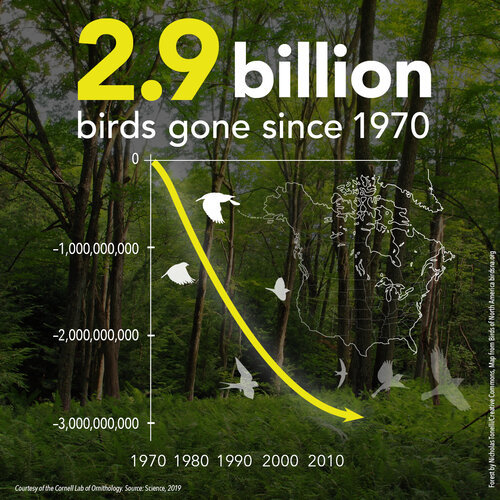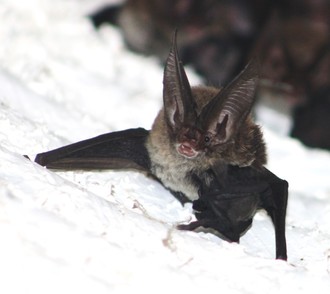 A new study reveals steep decreases in populations of North American birds.
A recently published study in the journal Science has revealed shocking declines in bird populations across North America. Since 1970, we have lost 2.9 billion birds. That number translates to nearly 1 in 3 birds that have been lost. This number was staggering to even the scientists behind the paper, who have dedicated their careers to the study of ornithology and are very familiar with the challenges facing our birds.
Surprisingly, some of the species that have experienced the greatest declines are some of the most common. Over the last 50 years, we have lost enormous numbers of familiar birds like Red-winged Blackbirds, Blue Jays and White-throated Sparrows. “Keeping common birds common” has been a rallying cry for conservationists, and it seems that this is even more important than we previously thought.
The loss of these wonderful animals is devastating in and of itself, but it is also a sign of much larger problems. Birds are excellent indicator species – they are sensitive to changes in their environments and we have abundant data on birds from both professional researchers and citizen scientists. When we know birds are in trouble, we can infer that the ecosystems to which they are intricately linked are also in trouble. Many of the factors that we know are causing bird population declines – climate change, habitat loss, pressure from invasive species and pesticide use – also affect countless other species of plants and animals.
The findings of the study aren’t all bad news – in fact, some groups of birds have increased population sizes due to directed conservation efforts. Woodpeckers, birds of prey and waterfowl have all seen their populations grow as we have protected their habitats and food sources from degradation and loss. The other good news – there are concrete actions you can take to help bird populations. There are 7 simple steps you can easily take to make a difference, many of which already will be familiar to our readers. Preventing window strikes, landscaping with native plants, keeping cats indoors, avoiding pesticide use, drinking bird-friendly coffee, reducing plastic use and participating in citizen science initiatives are all actions you can take to protect bird species today. Another important step? Make sure that you are a voice for birds. Share this news with friends and family on social media or by word of mouth!
 The Rafinesque big-eared bat, one of 13 bat species native to Florida, certainly lives up to its name. FWC photo.
October is here, which means that it is officially spooky season! As Halloween decorations go up on front porches and in storefront windows, you’ll likely see plenty of bats. While these creatures may give many people the heebie-jeebies, they are important and fascinating animals that provide invaluable ecosystem services.
Florida has 13 native bat species, all of which are insectivores. One bat can eat huge numbers of insects in a single night! Multiplied across all the bats in a region, their insect consumption adds up – they can help control the numbers of biting insects like mosquitos that may spread disease in humans. They also help to control agricultural pests; it is estimated that across the United States, bats eat enough insects to save $3.7 billion by reducing crop damage and the need for pesticide use.
Bats are often feared and vilified for spreading disease. While bats, like all mammals, have the potential to spread rabies, this disease is less common in bats than in racoons and foxes. In the United States, there are on average only two deaths per year attributed to rabies. Bats aren’t as dangerous as they are often thought to be. Still, it is important to avoid physical contact with bats, and to seek medical attention if you have been bitten by a bat or other wild mammal.
Bats may have much more to fear from us than we do from them. Two of our resident bat species, the Florida bonneted bat and the gray myotis, are federally endangered, and all species are threatened by loss of their natural roosting sites in caves and trees. Luckily, there are some things you can do to help Florida’s bats! You can preserve roost sites such as dead palm fronds and trees with peeling bark or cavities, or create new roost sites by putting up bat boxes. You can also report any unusual bat behavior to FWC to help our biologists monitor their health.
 The 1.75-mile Chain of Lakes Trail at Blackwater River State Park winds through several unique habitats, including longleaf pine forest. Photo courtesy of FDEP.
Last month, we visited Blackwater River State Park in Santa Rosa County. This park is tucked away in a quiet corner of the Panhandle, about a 40-minute trip northeast from Pensacola, and is well worth the drive.
During our visit, we took a stroll along the 1.75-mile Chain of Lakes Nature Trail. Despite its short length, this trail will take you through three very distinct habitats – across the river floodplain, along a chain of oxbow lakes, and through gorgeous longleaf pine habitat. The diversity of habitats here translates into a diversity of flora and fauna, as well. Visiting on a hot, sunny late afternoon in September, our bird list was relatively short (though we did enjoy seeing Red-headed Woodpeckers and Belted Kingfishers) – but we did get the chance to see lots of butterflies drinking nectar from the abundant wildflowers, and managed to find and ID enough new species to get our next Wings Over Florida butterfly certificates!
In addition to birding, Blackwater River State Park offers opportunities for hiking, camping, swimming, and paddling or tubing on the beautiful Blackwater River. If you want more to explore, there is plenty of opportunity in the surrounding Blackwater River State Forest, with trails, campsites, and exciting habitats to explore. More than 691 species have been recorded here on iNaturalist, including plenty of butterflies, dragonflies, wildflowers, and carnivorous plants.
Address: 7720 Deaton Bridge Rd, Milton, FL 32564
Phone: (850) 983-5363
Hours: 8 a.m. until sundown
Fees: $4 per vehicle
October 26 – Scrub-Jay Trail Day (Clermont)
October 26 – Hernando Audubon Society Trip to Cypress Lakes Preserve (Ridge Manor)
October 26 – Oakland Wildlife and Heritage Festival (Oakland)
October 26 – Nature Bioblitz Series (Clermont)
November 2 – Scrub-Jay Trail Orientation (Clermont)
November 2 – Field Trip to Kingsley Plantation (Jacksonville)
November 2 – Insect Safari (Oakland)
November 3 – Beginner Bird Walk and Fort Caroline National Memorial (Jacksonville)
November 9 – Birding Masters Tract with SJCA and Duval Audubon (Hastings)
November 9 – STA 5/6 Driving Bird Tour (Clewiston)
November 9 – Nature Bioblitz Series (Clermont)
November 10 – Field Trip to Camp Blanding Wildlife Management Area (Starke)
November 10 – Guided Bird Walk and Anastasia State Park (St. Augustine)
November 10 – Guana Sea Watch (Ponte Vedra)
Check out the events page of our website for more events across the state!
Do you know about any other bird- or wildlife-related events going on in Florida? Help spread the word by letting us know! Send in the times, dates, locations and contacts to wildlifeviewing@myfwc.com for posting on the Great Florida Birding and Wildlife Trail website.
Events must be related to birds or other wildlife and must be open to the public. Examples include interpretive programming, summer camps and family programs.
|